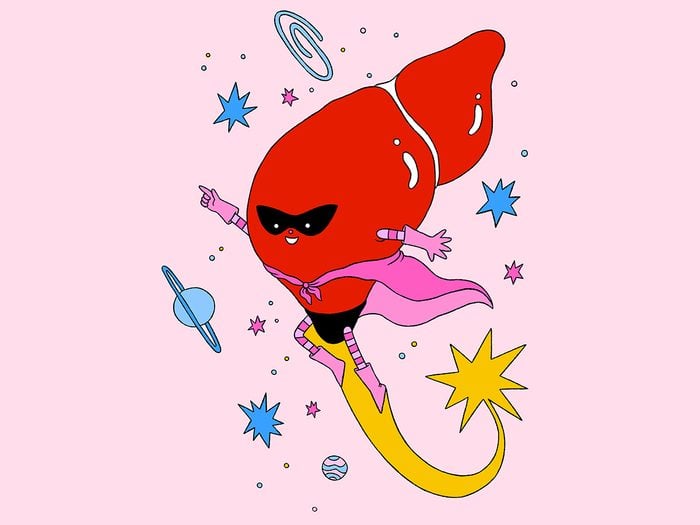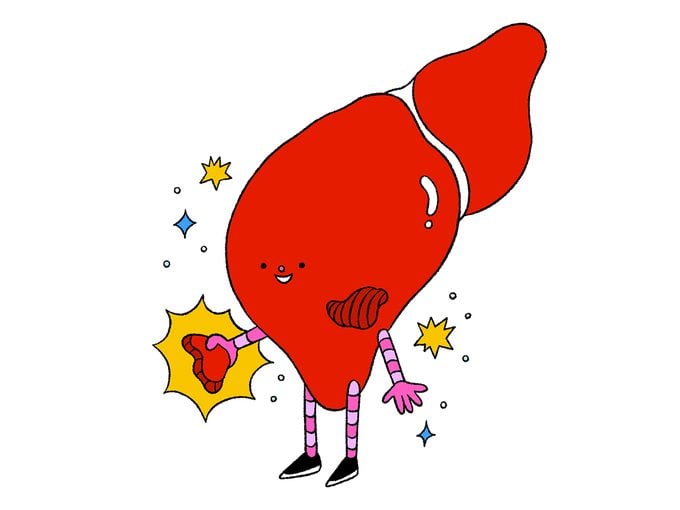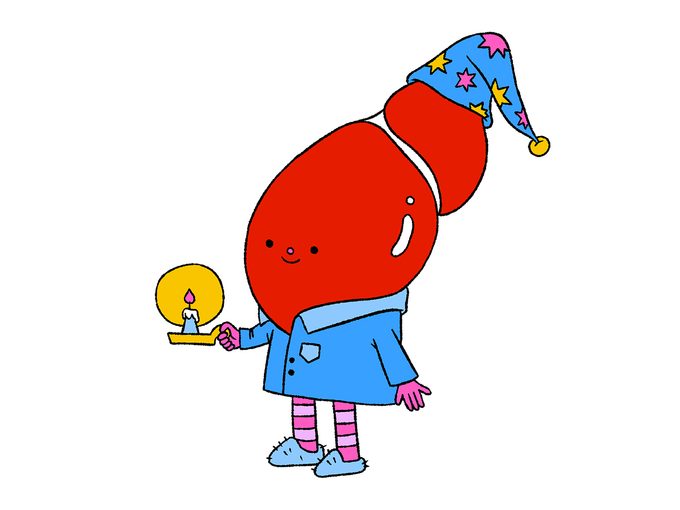Your Liver Is a Silent Superhero—Here’s Why

It converts food to fuel and governs your circadian rhythm. Most impressively, you can lose 70 percent of it and it’ll rapidly grow back.
Liver—yes, even when it’s chopped—deserves far more respect than our culture doles out. The human liver performs upward of 500 functions: It filters our blood and regulates clotting, it’s the first line of defence against infection, it controls the balance of hormones and fats and it transforms our food into energy, and that’s just for starters. But its chief marvel lies in its power to regenerate—lop off a giant chunk of a healthy liver and the damn thing will grow back. Not part of the way. Not eventually. You can lose a whopping 70 percent of your liver and, only 12 weeks later, possess a full-sized replacement that behaves like brand new. No other organ in our body can do this. “That rapid regeneration is phenomenal, and the question is: How does it know when to stop?” says Sonya MacParland, the Canada research chair in liver immunobiology and a senior scientist at the Toronto General Hospital Research Institute. “If the liver constantly had this function, then you would be all liver. But somehow you don’t just blow up like a balloon.”
There’s plenty we don’t know about this organ. Why does scarring of the liver wreak havoc on our memory? Why does it secrete a hormone that might determine whether we have a sweet tooth? Why do female livers metabolize drugs more quickly, making women far more likely, regardless of age, weight or the amount of anesthesia given, to wake up during surgery? Here’s what we do know: The liver is roughly the size and shape of a slightly deflated football and sits in the upper right quadrant of our abdomen, just below the diaphragm. It weighs around three pounds, with a deep reddish-brown colour that comes from being positively saturated with blood—at any given moment, about 13 percent of our body’s supply.
Most of the liver’s 500-plus functions are performed by cells called hepatocytes. “They make up 80 percent of the cells in the liver,” MacParland says, “and they’re really the body’s workhorses.” Hepatocytes help the liver store iron, generate cholesterol and make the proteins that transport vitamins, enzymes and hormones throughout our bodies. They help produce the bile that whisks away waste and breaks down fats. They play a pivotal role in our immune system, helping to seek out and destroy invading bacteria and viruses. And they help store or release glucose, depending on the up-to-the-moment energy needs of our bodies and minds. “What’s unique about hepatocytes is their ability to perform many more functions than other cells in the body,” says Mamatha Bhat, a hepatologist and clinician scientist at the University Health Network’s Ajmera Transplant Centre.
But they are not, crucially, the only cells lurking in the liver. For decades, scientists studied the organ as a soup of cells, rather than as individual components—with predictably hepatocyte-heavy results. “Imagine a smoothie that is 80 percent banana,” MacParland says. “I can sneak in some avocado, maybe a bit of blueberry, and my kids will say it’s a lovely banana smoothie. That’s great for feeding my children, but not so great when we’re trying to figure out an organ.” And it’s those very small populations of less-detectable cells that, once dysregulated, can really drive disease.
So in 2018, MacParland and her colleagues created the first-ever map of the human liver, all the way down to the single-cell level. Using that detailed information, researchers can finally understand the different cell populations that make up a healthy liver, along with the ones that act out when things go wrong. And lots can go wrong in such a multitasking organ: There are more than 100 types of liver disease that together may affect 1 in 4 Canadian men, women and children. Non-alcoholic fatty liver disease is especially prominent, affecting 7 million people in Canada alone. Most experience no symptoms—you don’t tend to feel the damage to your liver until its functioning drops below 20 percent—but, left untreated, it can lead to cirrhosis and even cancer.
Still, there are reasons to be optimistic. Right now, transplantation may be the only option for patients with end-stage liver disease. But MacParland’s map can help inform more precise therapies, as researchers better understand how to reprogram the liver so patients don’t necessarily need a new organ. “The cool thing about certain subpopulations of cells is they’re actually very, very reprogrammable,” she says. “When we know how the cells are misbehaving, we can target therapies that reprogram those cells and get them to promote regeneration.” Bhat, meanwhile, works closely with computer scientists on algorithms to improve the trajectories of patients who do have transplants. AI tools can predict the individual risk of infection and disease for each patient, and personalize treatment and care to boost their long-term outcomes.
It’s a rare chance for tech to help a liver out. Mechanical ventilators can breathe for our lungs. Dialysis machines do the work of kidneys. Ventricular assist devices will pump for weakened hearts. “But it’s not actually possible to replace the liver with any machine,” Bhat says. “Its functions are just too complex.” So put some respect on the liver, chopped or otherwise—this organ is no superfluous side dish. It has main character energy that can’t be denied.

Growth Opportunity
During her residency in internal medicine, Mamatha Bhat, a scientist at the University Health Network’s Ajmera Transplant Centre and Toronto General Hospital Research Institute, sat in on a transplant for a patient with end-stage liver disease. Once the healthy organ was attached, the transformation was dramatic—and exceptionally fast. “I saw jaundice fully resolved within hours,” Bhat says. “The liver function just picked right up; it was quite amazing.”
At any given moment, hundreds of people are waiting on Canadian liver transplant lists. In 2022, according to data from the Canadian Blood Services, there were 520 people across British Columbia, Alberta, Ontario, Quebec and the Atlantic provinces. At least a quarter of them will die before they make it off the list. “Unfortunately, there remains an imbalance between the supply of organs and the need for them,” Bhat says. But remember that whole business about the liver’s remarkable power to regenerate—growing from 30 percent of its size back to normal volume in just 12 weeks. We leverage that rapid liver regeneration in our program, which is the largest living donor liver transplant program in Canada, to save the lives of people on that list,” she says.
If you’re between the ages of 16 and 60 and in good health, you could help with this life-saving work. Living donation is not minor surgery: The operation lasts about six to eight hours, removes at least half of your liver (usually the entire right lobe) and requires a five- to 10-day stint in the hospital. Full recovery will take another six to eight weeks, though your organ will function like normal right after the surgery. As for that donated liver, it’ll be matched with a patient on the transplant list based on compatible size and blood type. But here’s a wild fact: You can put a liver that’s a little too large into someone who’s a bit smaller, and the liver will actually shrink to fit.
“Out of the more than 200 liver transplants we perform in our program each year, 70 to 80 percent are from living donors, and there’s even a certain percentage that are from anonymous living donors,” Bhat says. “It’s beyond being a good samaritan. It’s just a completely selfless act.”
The Sweet Spot
When you last went to the movies, did you settle in with a bucket of popcorn? Or did you chase gummy bears with M&Ms instead? After running the bloodwork on more than 6,500 Danish participants, researchers at the University of Copenhagen found a link between a liver-secreted hormone called fibroblast growth factor 21 (FGF21) and people’s appetite for sugary treats.
FGF21 seems to act like a candy-coloured stop sign. When researchers measured its levels in study participants who’d fasted for 12 hours, they discovered that sweets-scorning Danes had 50 percent more FGF21 in their systems than those who confessed to a serious sweet tooth. And the composition of the gene matters, too. Some participants had particular—and apparently weakened—variations of FGF21. Those folks were much more likely to eat larger amounts of gummies and sweets.
What does it mean? Like much that has to do with the liver, it’s an ongoing question. But the results suggest that our livers do send out signals about the foods and nutrients that we need. And now, when you find yourself forgoing the chips for a Hershey bar, you know which organ to blame.

Snooze Patrol
The brain gets all the credit for serving as our master biological clock: It’s the circuitry that governs our circadian rhythms, the 24-hour cycle dictating everything from our appetite and body temperature to our sleepiness, immune system and mental health. But what if—you guessed it—the liver had something to do with these rhythms as well? Euro-pean researchers set out to see if they could make the connection.
Back in 2017, working with mice, which also run on a 24-hour clock—the researchers were amazed to find that livers grow and contract by more than 40 percent over the course of the day. Because mice are nocturnal, eating by night and dozing during the day, the size of their livers nearly doubles after dark. It makes sense: Liver cells need to work hard to convert food into fuel, so they swell to ensure peak production. But once it’s bedtime, there isn’t the same need for that effort, so the liver powers down to conserve energy.
Here’s the catch. When researchers messed with the mice’s circadian rhythms, forcing them to stay awake and feed during the day instead of at night, their livers didn’t undergo the same growth and contraction, even if the mice were eating the same amount. It suggests that the cues that spur our livers into action don’t come from our food—they come from the biorhythm that’s evolved in us over hundreds of millions of years.
So what happens when mice are wound up using a different clock altogether? Last year, some of the same European researchers returned for another experiment. This time, they switched out the liver cells in the mice with human liver cells, and, all of a sudden, the mice started to look a lot less nocturnal. Their daily cycle moved forward, and they began to eat and be active a full two hours before nightfall.
These twin studies underscore the intimate relationship between our liver and our biological clock. And that’s important, because all sorts of modern interventions, including night-shift work, jet lag and the blue light of our laptops and phones, conspire to throw that innate sense of time out of whack. It’s clear already that night-shift work, for example, carries the risk of all sorts of adverse health effects, including cardiovascular disease, diabetes and cancer. The researchers suspect that deregulation of our biological rhythms also has significant consequences for the functions of our liver—and, as we know, the liver controls an awful lot.




